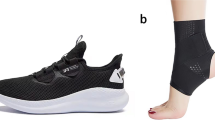Abstract
Acute post-stroke rehabilitation protocols include passive mobilization as a means to prevent contractures. A device (SHADE) that provides repetitive passive motion to a flaccid ankle by using shape memory alloy actuators could be of great help in providing this treatment. A suitable actuator was designed as a cartridge of approximately 150 × 20 × 15 mm, containing 2.5 m of 0.25 mm diameter NiTi wire. This actuator was activated by Joule’s effect employing a 7 s current input at 0.7 A, which provided 10 N through 76 mm displacement. Cooling and reset by natural convection took 30 s. A prototype of SHADE was assembled with two thermoplastic shells hinged together at the ankle and strapped on the shin and foot. Two actuators were fixed on the upper shell while an inextensible thread connected each NiTi wire to the foot shell. The passive ankle motion (passive range of motion, PROM) generated by SHADE was evaluated optoelectronically on three flaccid patients (58 ± 5 years old); acceptability was assessed by a questionnaire presented to further three flaccid patients (44 ± 11.5 years old) who used SHADE for 5 days, 30 min a day. SHADE was well accepted by all patients, produced good PROM, and caused no pain. The results prove that suitable limb mobilization can be produced by SMA actuators.








Similar content being viewed by others
References
J. Mackay, G. Mensah (Eds.), Atlas of Heart Disease and Stroke. World Health Organization, Geneva, Switzerland, 2004
L.M. Brass, Stroke, Chap. 18, The Yale University School of Medicine Heart Book, 1st ed., B.L. Zaret, M. Moser, and L.S. Cohen, Eds., William Morrow & Co, 1992, p 215–234
NINDS (National Institute of Neurological Disorders and Stroke), Post-Stroke Rehabilitation Fact-Sheet, NIH Publication number: 02-4846, Office of Communications and Public Liaison—National Institute of Neurological Disorders and Stroke—National Institutes of Health, Bethesda, MD, 2002
L. Harvey, R. Herbert, Muscle stretching for treatment and prevention of contractures in people with spinal cord injury, Spinal Cord, 40, 2002, p 1-9.
J-M. Gracies, Pathophysiology of spastic paresis I: paresis and soft tissue changes, Muscle Nerve, 31, 2005, p 535–551
P.W. Duncan, R. Zorowitz, B. Bates, J.Y. Choi, J.J. Glasberg, G.D. Graham, R.C. Katz, K. Lamberty, D. Reker, Management of Adult Stroke Rehabilitation Care. A Clinical Practice Guideline, Stroke, 36, 2005, p e100-e143.
G. Kwakkel, R. van Peppen, R.C. Wagenaar, S. Wood Dauphinee, C. Richards, A. Ashburn, K. Miller, N. Lincoln, C. Partridge, I. Wellwood, P. Langhorne, Effects of augmented exercise therapy time after stroke: a meta-analysis, Stroke, 35, 2004, p 2529-2536
S. Masiero, A. Celia, G. Rosati, M. Armani, Robotic-assisted rehabilitation of the upper limb after acute stroke, Arch Phys Med Rehabil, 88, 2007, p 142-149
S. Pittaccio, S. Viscuso, M. Rossini, L. Magoni, S. Pirovano, S. Besseghini, and F. Molteni, SHADE: An Active Orthosis for Safeguarding Ankle Motion Skills in Dropfoot Patients, Proceedings of the 4th World Congress of the International Society Physical and Rehabilitation Medicine, U.W. Rah, Ed., June 10–14, 2007 (Seoul), Organizing Committee of ISPRM, 2007, p 360
S. Pittaccio, F. Zappasodi, S. Viscuso, F. Mastrolilli, M. Ercolani, F. Passarelli, F. Molteni, P.M. Rossini, F. Tecchio, Cortical correlate of passive mobilisation of the ankle joint by means of the SHADE orthosis, Clin Neurophysiol, 119 (Suppl 1), 2008, p S20.
Author information
Authors and Affiliations
Corresponding author
Additional information
This article is an invited paper selected from presentations at Shape Memory and Superelastic Technologies 2008, held September 21-25, 2008, in Stresa, Italy, and has been expanded from the original presentation.
Rights and permissions
About this article
Cite this article
Pittaccio, S., Viscuso, S., Rossini, M. et al. SHADE: A Shape-Memory-Activated Device Promoting Ankle Dorsiflexion. J. of Materi Eng and Perform 18, 824–830 (2009). https://doi.org/10.1007/s11665-009-9405-y
Received:
Revised:
Accepted:
Published:
Issue Date:
DOI: https://doi.org/10.1007/s11665-009-9405-y




